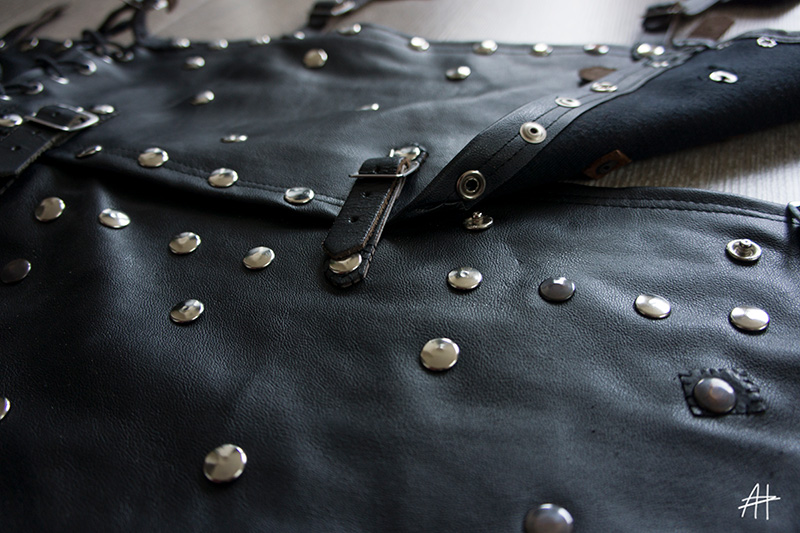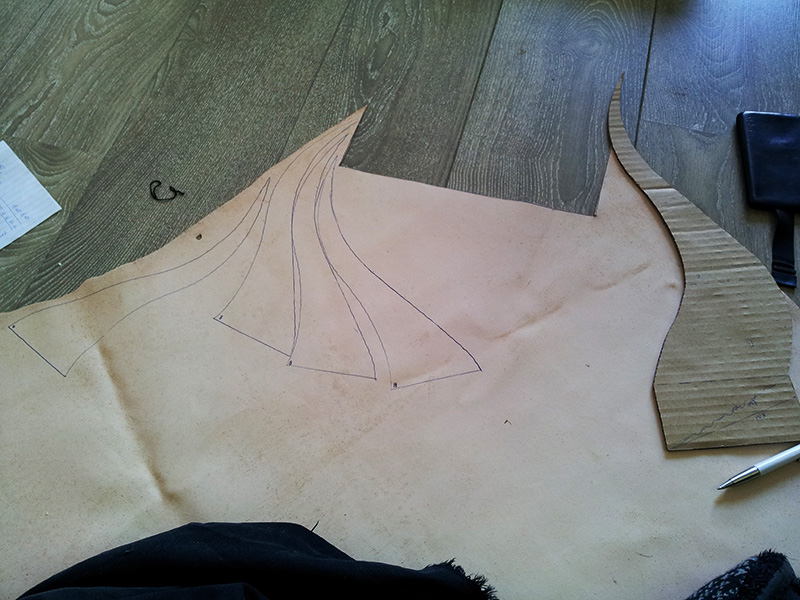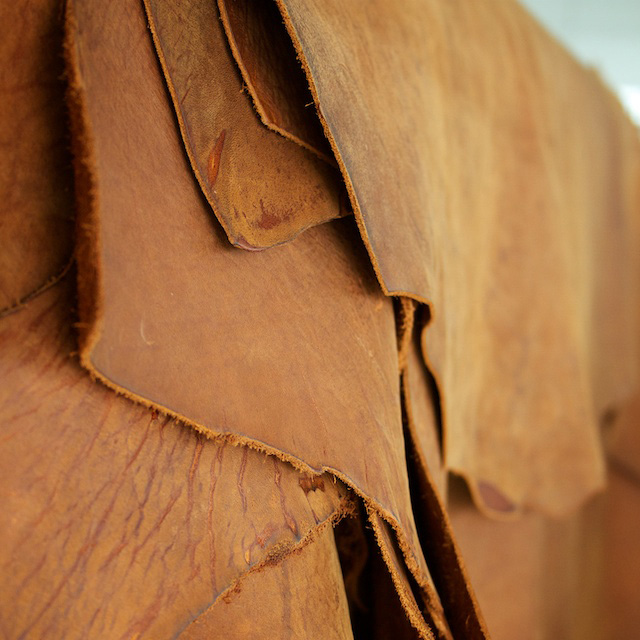Armour: Leather
Armour is often used as part of a costume at a larp. This week I’m going to tell you about leather; which is one of the common types of armour used.
Enjoy! Alexjuh
In the next couple of entries I’m going to tell you about different types of armour. This entry will be about leather armour.

Model: Bart Holsbergen
This armour is custom-made by Ben Loder
This material is often used for armour. People tend to choose this type of armour because it gives a decent protection, is lighter than any type of metal armour and is not as warm as fur (which is sometimes classified as armour). There are different types of leather but I’ve divided them into two categories: fake leather and real leather.
Fake leather
Fake leather is very light and a lot cheaper than real leather, two of the main reasons people use this. It can be bought at fabric-stores, markets and the internet, and it’s available in a lot of different colours. For fantasy-larps people often use black and brown because brown is a natural colour and black is an accepted alternative. In these types of larps other colours are often used to detail something. For other larps silver is a popular colour, but any other colour can be used. I can imagine using an intense blue for a sci-fi larp.
Fake leather is also easy to process because you can use normal scissors to cut it and can be sewn together with a normal sewing-machine.
Fake leather is also very flexible giving you more freedom of movement.
However, this type of leather can look very fake. It usually has a gloss to it and the ones who don’t have a gloss look a lot more like plastic than actual leather. This is one of the big cons on using fake leather. And because of the little layer of plastic used on fake leather it doesn’t ‘breathe’, causing you to overheat more easily. Due to this same layer it can be very cold in winter when you put it on, but after a while it’s only very warm.
Fake leather is also very thin and thus it tears easily. You can use multiple layers but that will only add to the warmth.
When you use only one layer and you want to put rivets in it to make studded leather armour, you’ll find yourself putting in new rivets every time you’ve used it because it tears so easily and the rivets fall out.

Real leather
Real leather comes from animals, often a cow. A cow has a very thick skin so different types of leather can be produced from it. Frankly, I don’t know a lot about these different types of leather (except for split leather with which I have some experience) so I consulted the internet and found some useful information.
- Full-grain leather refers to hides that have not been sanded, buffed or snuffed to remove imperfections (or natural marks) on the surface of the hide. This leather has breathability, resulting in less moisture from prolonged contact. Rather than wearing out, it will develop a (mate) gloss over time. This is by far the most expensive type of leather but it has a long durability and is very strong.
- Top-grain leather is the second-highest quality. It has had the “split” layer separated away making it thinner and more pliable than full-grain. Its surface has been sanded and a finish coat added to the surface which results in a colder, plastic feel with less breathability, and it will not develop a natural gloss. It is typically less expensive and has greater resistance to stains than full-grain leather, so long as the finish remains unbroken.
- Corrected-grain leather is any leather that has had an artificial grain applied to its surface. The imperfections are corrected or sanded off, and an artificial grain impressed into the surface and dressed with stain or dyes.
- Split leather is leather created from the fibrous part of the hide left once the top-grain of the rawhide has been separated from the hide. This is the cheapest real leather but doesn’t have a very long durability. This type of leather is the easiest to process yourself but beware not to take the thinnest parts of the skin (usually where the legs start) because this will tear quickly when you put some tension on it.

Real leather is expensive, which is the main reasons it scares people of. Raw leather is a lot more difficult to process which is one of the reasons why it is so expensive. It needs to be cut (and depending on the thickness it takes a lot of sharp tools), painted with special paint, finished off such as rounding the edges, and maybe put on some decoration for which specials tools are needed.
When you want leather armour (pieces) you can buy them often at larp- and re-enactment shops that have a selected assortment but you won’t have a unique costume piece. You can order customised pieces, which gives you something unique but this is very expensive. There are a lot of people who are specialised in working with leather, especially in the larp-commune, but you have to find a good one. It’s possible that you (have to) order a piece by someone living in a different country making it even more expensive due to shipment costs.
When you have a piece of armour made out of thick leather you will also have limitations to your movement.
If you’re going to work with leather keep in mind that it won’t be easy, takes a lot of time, possibly will give a lot of frustration and can get very expensive.
As you can see, working with leather has a couple of cons that can make you think twice about working with this stuff. But why do people buy and use real leather when there are so many cons? Well, because of its looks. If you have a proper made leather piece it will stand-out so much more than fake leather.
Real leather has a long durability and is very strong. It also gives some out-of-game protection when you are in a fight; real leather will absorb the blow from a weapon much better than a thin layer of fake leather.
On top of that, my experience with real leather is that it breathes a lot better thus is less warm and makes you sweat less.
When you use thick leather it’s also easily possible to put rivets in it to create studded leather armour. Real leather won’t tear that easy and will hold your rivets.

People who start with larp or don’t have much money tend to choose for fake leather. When people have more experience with larp (and with creating things themselves) and/or have more money to spend, they often choose for real leather. So both types of leather have pros and cons, it’s up to you which one you prefer to use.
Special mention for this entry: Doomsday General. Thank you for your input on this topic and for helping me with translation, grammar and filtering out little mistakes.
Next entry: Armour, metal
Dit artikel is oorspronkelijk gepost op Alexandra’s blog (14 april 2014) en is opnieuw beschikbaar gesteld voor LARP Platform.
Alexandra is momenteel actief met het organiseren van Dark Union, een unieke bad guy LARP in Nederland. Daarnaast is ze heel creatief meer leerbewerken onder handelsnaam Layers.
Aanmelden nieuwsbrief
Contact
Wil je samenwerken met LARP Platform, heb je vragen of opmerkingen? Neem dan contact met ons op.
LARP Platform is onderdeel van Stichting Verhaal in Uitvoering.